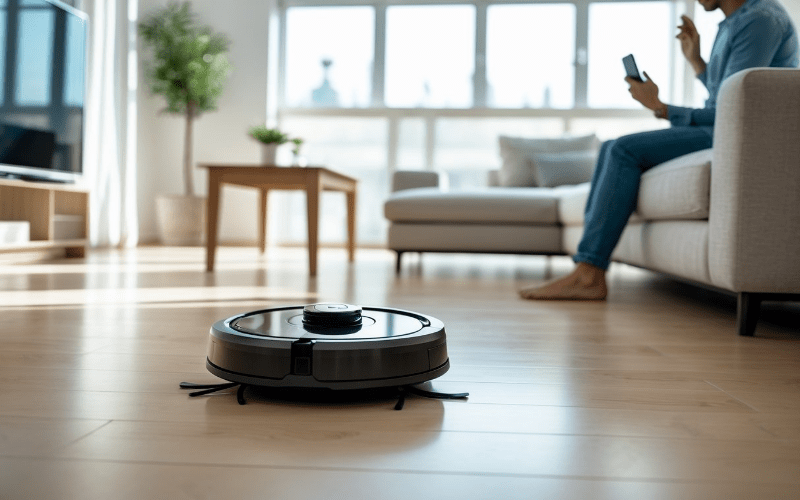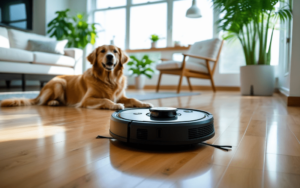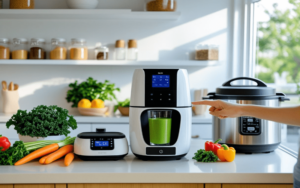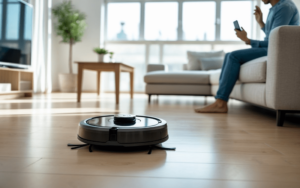Choosing the right robot vacuum can save you time and keep floors consistently clean with less effort. There are so many models out there, and each one promises something a little different. Some boast strong suction or smart navigation, while others struggle with pet hair or mapping your place.
If you know what matters most, it’s easier to dodge common mistakes and avoid wasting money. Smart connectivity, cleaning modes, and maintenance all play a role in finding a machine that fits your needs. A helpful robot vacuum guide can make the search less overwhelming.
Key Takeaways
- Focus on the features that matter and skip the extras you don’t need.
- Compare brands and models for the best cleaning results.
- Make sure the vacuum fits your home’s needs and maintenance habits.
Please note that this article contains affiliate links. We may earn from qualifying purchases at no extra cost to you.
Understanding Robot Vacuum Basics
Robot vacuums use smart sensors, suction, and software to clean floors with little effort from you. Some offer simple cleaning patterns, while others rely on advanced mapping, Wi-Fi controls, and extra features.
How Robot Vacuums Work
Robot vacuums move around your home and clean floors using a mix of hardware and software. Most have wheels, a motor, brushes, and enough suction to pick up dirt and dust.
Sensors help them avoid walls, furniture, and stairs. Basic units use random navigation and bounce off obstacles, covering spaces slowly. Advanced models use lasers, cameras, or mapping to learn your home’s layout.
You can usually set cleaning times or schedules. Some models offer app controls so you can start or stop cleaning from your phone. When the battery runs low, most robots head back to their charging dock by themselves.
Types of Robot Vacuums
Robot vacuums really range in features and price. Entry-level robots are smaller, with basic suction and random movement. They’re best for small homes and hard floors, but usually don’t have mapping or app control.
Mid-range models have stronger suction and better navigation. Many can handle pet hair, rugs, and moving between different floor types. Some add virtual barriers or let you pick which rooms to clean.
High-end vacuums come with smart mapping, multiple cleaning modes, voice commands, and Wi-Fi. Some can mop as well as vacuum. Tall, bulky machines might not fit under furniture, but low-profile robots reach more spots. To see the differences, check out this guide to robot vacuums.
Find our best Amazon Picks here
Find our best Ecovacs Deepot Picks here
Key Advancements Over Time
The earliest robot vacuums followed simple paths and got stuck a lot. Over the years, they’ve gotten smarter, using mapping and navigation to avoid missing spots.
Wi-Fi connectivity lets you control cleaning from anywhere. Batteries last longer now, so some robots can run for hours before recharging. Newer features include dirt detection, custom cleaning schedules, and automatic dustbin emptying.
Today’s robots are more compact and easier to store. For a closer look at how size and design matter, check this guide about robot vacuum size.
Essential Features to Consider
A robot vacuum can save you time and keep floors cleaner, but it all comes down to picking the right features. Performance, smart tech, and convenience matter most when choosing a model.
Suction Power & Cleaning Performance
The main job of a robot vacuum is to pick up dust, dirt, and pet hair. Look for strong suction, usually listed in Pascals (Pa). Higher suction means it’ll pull up more from carpets and hard floors.
Some robots automatically adjust suction for different floor types. That’s handy if you have both carpets and hardwood. Good cleaning also depends on the brush and filter system. Anti-tangle brushes keep hair from wrapping around the rollers.
HEPA filters help trap allergens. Models with multiple cleaning modes, like spot or edge cleaning, give you more options. Checking cleaning tests or reviews gives a real sense of performance.
Navigation & Mapping Technologies
How well a robot vacuum gets around depends on its navigation. Budget vacuums might just bump around at random, missing spots.
Advanced models use sensors, cameras, or LiDAR to map your home. This lets them clean in neat lines, covering everything evenly. Smart navigation also helps them dodge obstacles and avoid stairs.
Some let you set up zones or no-go areas in an app. This is great for bigger homes or rooms with lots of furniture. Accurate mapping keeps robots from getting stuck or tangled up.
Buy our best Amazon Picks here
Buy our best Ecovacs Deepot Picks here
Battery Life & Charging
Battery life matters, especially if you’ve got a big place. Most robot vacuums run for 60 to 120 minutes per charge. If the battery runs out, smarter models return to their dock, recharge, and finish cleaning.
Pick a vacuum with enough battery to clean your space in one go. Fast recharging saves time between sessions. High-capacity batteries are better for large homes or multiple floors.
Some robots let you check battery status in the app. Automatic docking and charging should just work, so you’re not stuck plugging it in yourself.
Scheduling & Automation
Automatic schedules are a huge convenience. Most new robot vacuums let you set cleaning times in an app or with simple controls.
App-controlled scheduling means you can adjust days and times, even if you’re not home. Some vacuums let you clean certain rooms on different days. Voice assistant integration is handy for hands-free control.
Look for options that remember multiple schedules or routines, like extra cleaning during allergy season. For homes with busy schedules or pets, this is a lifesaver. For more on smart controls and app features, see this guide on choosing a robot vacuum.
Smart Connectivity & Compatibility
Smart features can make a robot vacuum easier to use and fit into a smart home. The right options allow for scheduling, voice commands, and linking with other devices for smoother cleaning.
WiFi & App Control
Most robot vacuums now have WiFi, so you can connect them to a smartphone app. These apps let you start, stop, or pause cleaning from anywhere. You can set schedules, target certain rooms, or check cleaning progress in real time.
Some apps let you make custom maps of your home. That way, the vacuum can skip certain spots or focus on others. Notifications alert you when the dustbin is full or if there’s a problem. It’s worth looking for models that support both iOS and Android.
Voice Assistant Integration
Robot vacuums with voice assistant support work with Alexa, Google Assistant, or Siri. You can use simple voice commands like “start cleaning” or “go to dock” without touching your phone.
Not every model supports every assistant, so check compatibility before buying. Some advanced robots let you use specific commands, like cleaning just one room. Voice control is great for hands-free cleaning or if you have mobility issues.
Manufacturers sometimes add or improve voice support with updates, so it’s smart to check for regular software upgrades.
Home Automation Ecosystem
Some robot vacuums work with a home automation ecosystem. The new Matter standard helps devices from different brands work together, making smart home setup less of a headache. Matter boosts compatibility and cuts down on setup hassles for smart robot vacuums.
Some vacuums connect with platforms like Samsung SmartThings or Apple Home. This lets you automate things, like starting a cleaning session after everyone leaves. Integration with these platforms means your vacuum can work alongside lights, locks, and other smart devices.
If you want to expand your smart home later, picking a vacuum with these standards is a good move.
Cleaning Capabilities & Floor Suitability
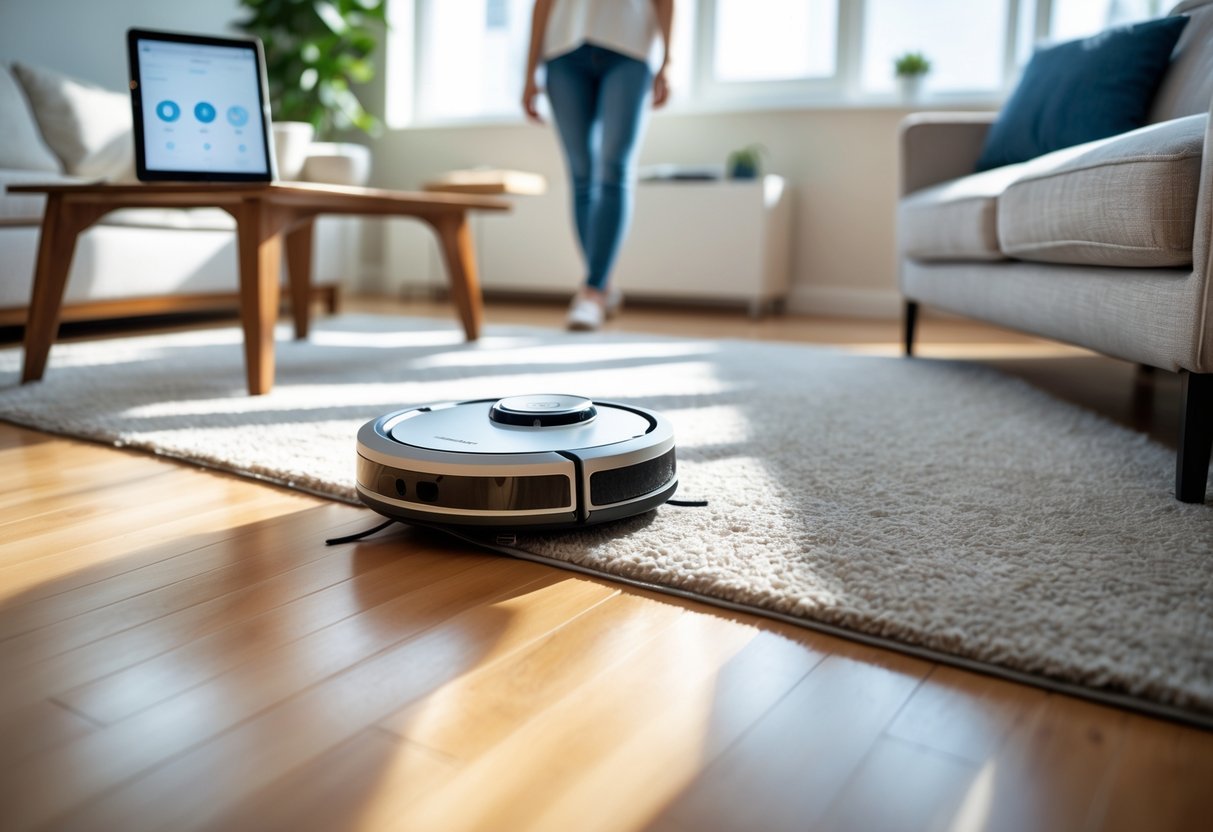
A good robot vacuum should handle a mix of surfaces and household messes. Different models offer cleaning modes, suction settings, and features for specific floor types, pet issues, and home layouts.
Performance on Different Floor Types
Robot vacuums really don’t behave the same on every surface. If your home is mostly hard floors—tile or hardwood—look for models with soft brushes and gentler suction. That helps avoid scratches and keeps the finish looking good.
Carpets and rugs are a different game. You’ll want strong suction to pull out dirt from deep in the fibers. Suction is measured in Pascals (Pa). For general cleaning, 2,000 Pa is usually enough, but if you’ve got thick rugs, 4,000 Pa or more makes a difference.
Some vacuums can actually switch between floor types on their own, raising or lowering their brush rolls as needed. That’s handy if you don’t want to babysit the thing. Low-profile units can sneak under furniture, so you won’t have to move your couch every week.
It’s worth thinking about your own flooring mix. Try to pick a vacuum that’s known for solid performance on different surfaces.
Pet Hair and Allergen Management
Pet owners know the struggle: hair and dander everywhere. You’ll want a vacuum with a brush roll that resists tangling, so you’re not always cutting hair off the rollers. Some models use rubber brushes, which are way easier to clean and less likely to clog up.
HEPA or high-efficiency filters trap tiny stuff like dander, pollen, and dust. That’s a big deal if you have allergies.
Daily or regular cleaning cycles help control allergens by picking up pet hair before it spreads. Self-emptying bases are a nice touch—they offer hands-free convenience and can collect pet hair for weeks.
Models like the iRobot Roomba j7+ and Shark IQ are built for pet hair, combining strong suction with anti-tangle technology. That combo really does help.
Obstacle Avoidance
Modern robot vacuums use cameras, sensors, or sometimes both to spot and dodge obstacles—think toys, cords, or the occasional pet mess. The fancier ones use mapping to remember your room layouts and set boundaries for where to clean.
This tech helps the vacuum avoid getting stuck. It’s surprisingly useful if you’re tired of rescuing your robot from under the coffee table.
Better obstacle avoidance means a smoother cleaning session. Some robots can even detect stairs and avoid taking a tumble.
Look for features like laser or visual navigation. They’re especially helpful in cluttered rooms or homes with lots of furniture and pet gear. Accurate obstacle detection improves overall cleaning performance.
Maintenance and Upkeep
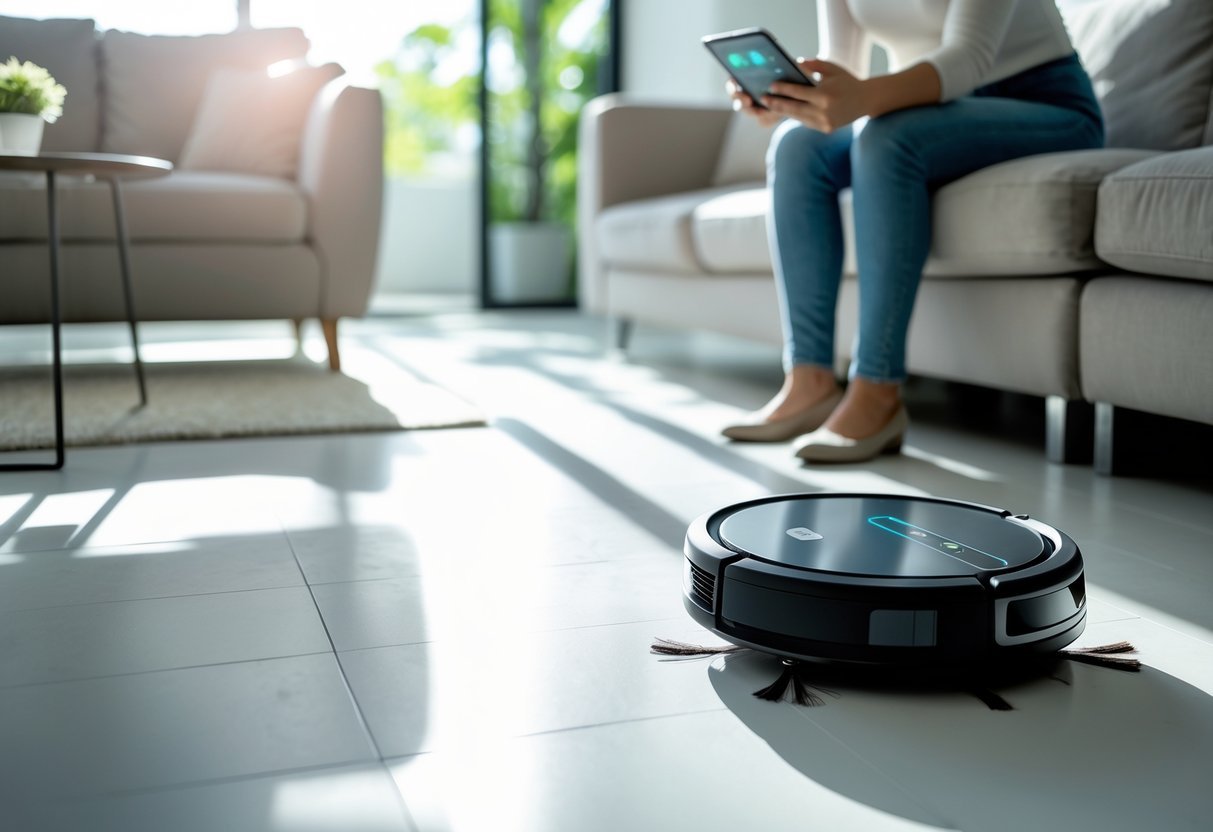
Regular maintenance is what keeps a robot vacuum running well. Simple stuff—emptying the dustbin, cleaning the brushes, updating the software—can help it last longer and clean better.
Dustbin Capacity & Emptying
Robot vacuums come in all shapes and sizes, and so do their dustbins. Larger bins can hold more dirt, so you’re not emptying them every day. Smaller dustbins fill up fast, especially if you have pets or a lot of dust.
Frequency depends on your vacuum’s size and how messy your place gets. Some folks need to empty the bin daily, others just a few times a week. If you let it overfill, you risk clogs and weaker cleaning performance.
Newer models sometimes have self-emptying bases. That means the vacuum dumps its load into a bigger bin at the dock. If you hate emptying bins, look for this feature.
A full dustbin blocks airflow and the robot will start missing dirt. It’s worth checking the bin after each run. That way, you keep strong suction and avoid headaches. There are more robot vacuum maintenance tips if you want to dive deeper.
Brush and Filter Care
Brushes and filters are the workhorses—they pick up dust, hair, and whatever else is on your floor. Brushes should be checked at least once a week for tangles, strings, or big chunks. Use the cleaning tool or scissors to cut out anything stuck.
Filters need attention too. Most basic filters do fine with a quick tap or gentle brush. HEPA or high-efficiency filters might need a rinse, but make sure they’re totally dry before putting them back in.
Stick to the manufacturer’s schedule for replacing filters and brushes. Some robots will remind you, but not all do—so maybe set a reminder. Regular care means more dirt gets picked up and helps prevent overheating. For more details, check out this robot vacuum maintenance guide.
Software Updates
Most robot vacuums these days use smart navigation and mapping, and that relies on up-to-date software. Updates can add features, improve cleaning, or fix bugs. Robots with Wi-Fi usually update through the app automatically.
It’s smart to check for updates in the app and let them install when prompted. Keeping firmware current helps your robot run smoothly and keeps up with new cleaning tricks.
Security patches come through updates too, especially if your vacuum connects to Wi-Fi. If you skip updates, you might leave your device open to issues. For peace of mind and the latest features, regular software checks are a good idea.
Pitfalls and Features to Avoid
Not every robot vacuum is a winner. Some models have reliability problems, gimmicky features, or unexpected costs that can turn a smart purchase into a headache.
Common Issues in Budget Models
Budget robot vacuums often struggle with suction, navigation, and build quality. Their sensors can be iffy, so they might bump into walls or get stuck on rugs and wires.
Cheap models can miss dirt along edges or in corners. Battery life is usually short, so cleaning cycles get cut off before the job’s done.
Basic models sometimes skip essentials like HEPA filtration or auto-docking. Some users complain about tiny dirt bins, which means you’re emptying them constantly.
Watch out for flimsy wheels or parts that break early. For more details and tips, check out this robot vacuum buying guide.
Overhyped Gimmicks
Some features sound great on paper but don’t really help. UV sterilization lights, for example, rarely clean in any useful way.
App-controlled spot cleaning zones might look cool, but if the navigation isn’t good, they’re not much use. Voice assistant integration is everywhere, but honestly, a manual start button works just as well for most people.
Expensive mapping on lower-end models can be unreliable. Not all extra modes actually improve cleaning.
It’s smart to question features that sound like tech buzzwords. If you want more info, here’s a guide on what to look for in a robot vacuum.
Hidden Costs & Extras
Replacement parts—side brushes, HEPA filters, mop pads—aren’t always included, especially with cheaper models. Over time, those costs add up. Some brands require you to buy their official parts, which are pricier.
Watch out for subscription fees for app features or smart mapping. Some vacuums need branded boundary strips, special cleaning liquids, or unique batteries, which can be annoying.
Warranty coverage is often limited with low-cost brands. Always check what’s included and whether replacement parts are easy to find. Here are some expert buying tips if you want to dig deeper.
Comparing Top Brands and Models
Robot vacuum brands have their own strengths. It’s worth comparing cleaning performance, smart features, and how easy they are to use before picking one.
iRobot Roomba Lineup
iRobot’s Roomba line has been around for years. They’re known for reliable cleaning, sturdy build, and a simple design.
Most Roombas offer multiple cleaning modes, smart navigation, and decent app controls. Newer models, like the Roomba j7+ and s9+, bring in precision mapping, pet hair removal, and automatic dirt disposal.
Many Roombas work with Alexa and Google Assistant, so you can use voice commands. People like the customer support and the fact that replacement parts are easy to find.
Roombas do cost a bit more than some other brands, but their consistent popularity and good cleaning performance make them a solid pick for most floor types.
Key Features:
- Multi-surface brushes
- Smart navigation and mapping
- Automatic dirt disposal (select models)
- Robust app controls
Roborock Options
Roborock is a solid choice if you want advanced navigation and strong cleaning. Many of their vacuums can vacuum and mop in one go.
Models like the Roborock S8 and S7 MaxV use LiDAR mapping for detailed navigation and can avoid obstacles pretty well. The app lets you set no-go zones and clean specific rooms, and it’s easy to use.
Battery life is usually long. Most models offer strong suction and do well on both carpets and hard floors. Prices range from mid to high, but you get flexible cleaning and detailed controls.
Highlights:
- Strong suction
- Accurate LiDAR navigation
- Mop and vacuum combo options
- User-friendly app controls
Ecovacs Alternatives
Ecovacs is another big player, offering robot vacuums with a bunch of smart features. The Deebot line is known for being affordable and packing in mopping features.
Some models, like the Deebot T20 and T10 plus, come with advanced mapping and self-emptying stations. Ecovacs vacuums offer custom schedules and multi-floor mapping, which is handy if you have more than one level.
Most models have both vacuum and mop functions, which is nice for mixed flooring. Voice control is common too, using Alexa or Google Assistant.
Ecovacs may not always be the best at obstacle avoidance, but they stand out for strong value and a mix of features for the price. They’re a popular pick if you’re budget-conscious but still want convenience.
Ecovacs Deepot T50 Pro has some great features
Notable features:
- Affordable models with powerful suction
- Mop and vacuum functions
- Self-emptying base (select models)
- Multi-floor mapping and custom scheduling
Making an Informed Purchase Decision
Choosing a robot vacuum isn’t just about grabbing the flashiest model. Buyers should really think about their own household needs first.
Floor type, whether you’ve got pets, and how often you plan to use the vacuum all matter a lot. These factors can make a bigger difference than you might expect.
It’s smart to check out product reviews and user feedback. You’ll get a sense of how a vacuum holds up after months of use—sometimes things change after that first week.
Many guides suggest paying close attention to cleaning modes, battery life, and smart mapping features. Honestly, some of those features sound fancy but might not matter in your daily routine.
Here’s a quick comparison table built from the stuff people care about most:
| Feature | Why It Matters |
|---|---|
| Battery Life | Longer cleaning between charges |
| Suction Power | Picks up dust and larger debris |
| HEPA Filter | Better for allergies and dust |
| Mapping Tech | Improves cleaning efficiency |
| App Controls | Easier scheduling and control |
Don’t get pulled in by every extra feature. Expensive models might have mopping or voice control, but do you really need them?
It’s worth checking out a few brands before settling. Sometimes the best value isn’t the most obvious pick.
Expert opinions and comparison guides from places like Robots.net or TechPP can help sort out what’s truly essential. A vacuum that fits your space and habits is usually the right call, not just the one with the longest list of features.
Don’t forget to look at warranty and customer support. If something goes wrong, you’ll want help that’s actually helpful.
Shop our best Amazon Picks here
Shop our best Ecovacs Deepot Picks here
This article contains affiliate links, which means we may earn a commission if you purchase through our links, at no extra cost to you. As an Amazon Associate and Awin Publisher, we earn from qualifying purchases with no extra cost to you. Thank you for supporting our content!

